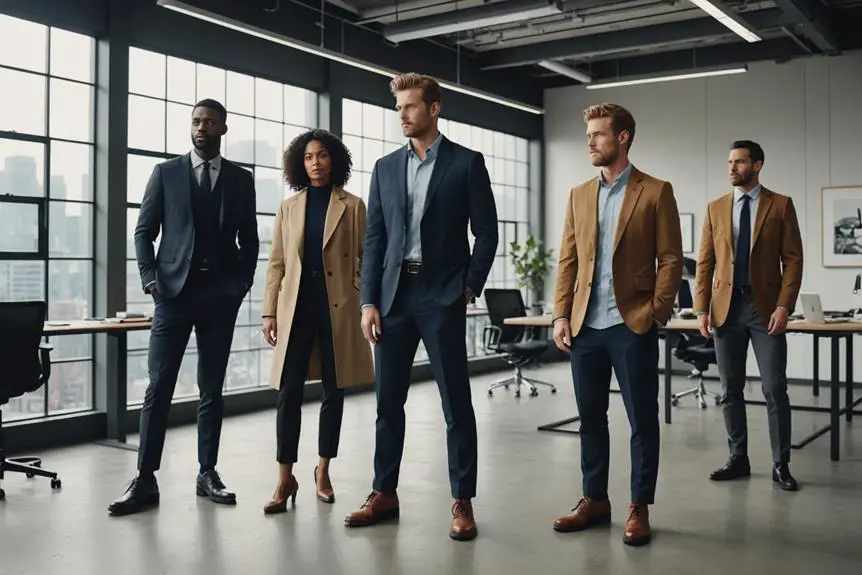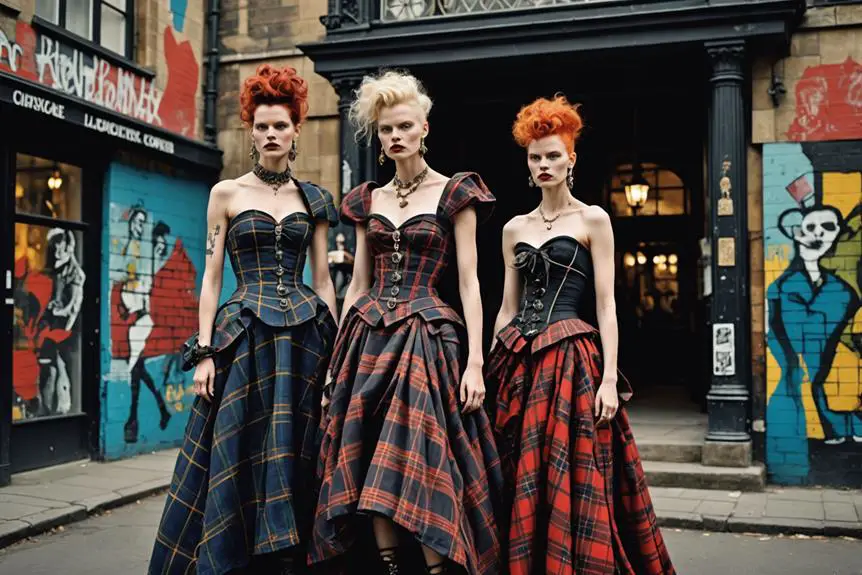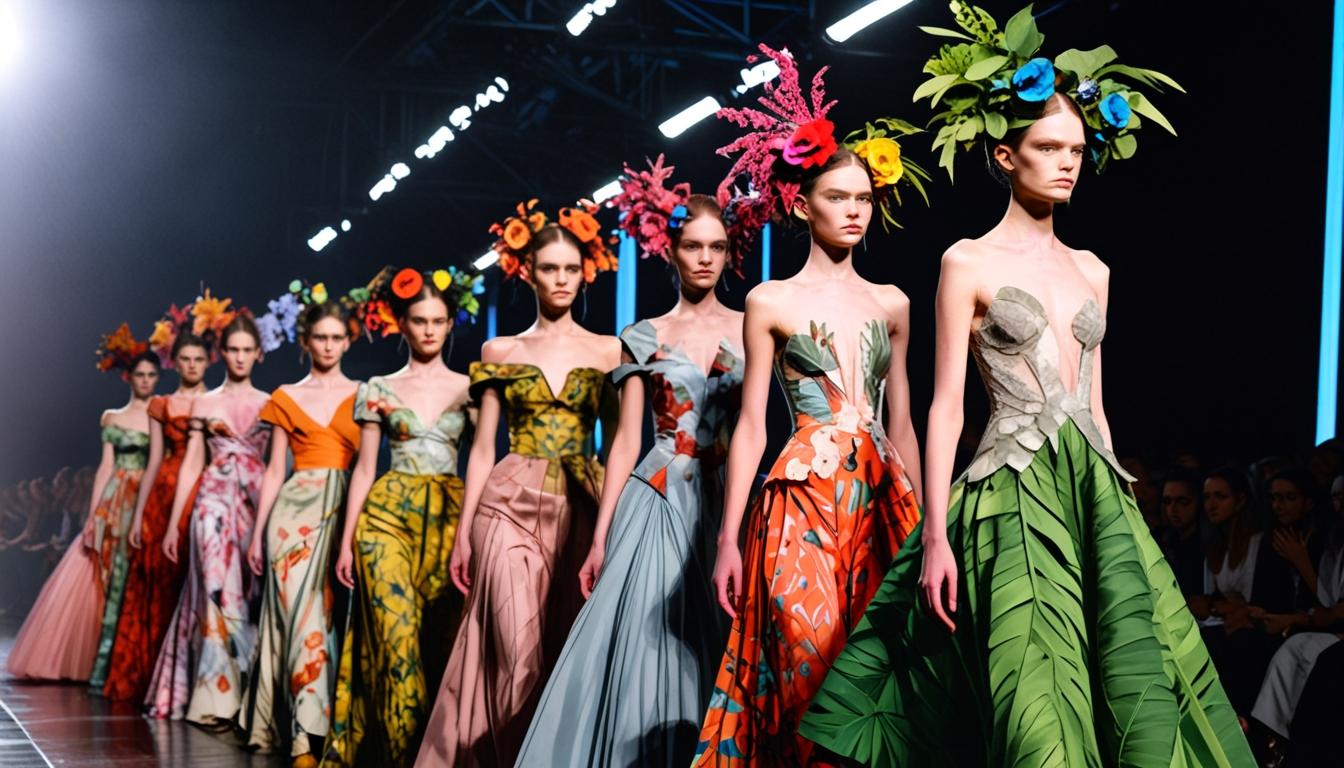You might think the 1970s were all about disco balls and bell-bottoms, but the decade actually revolutionized workwear in ways you wouldn't expect. As practicality took center stage, brands started blending comfort with style, changing how we view work attire today. From the rise of durable materials to the introduction of high-visibility clothing, this era laid the groundwork for modern designs. What specific styles and innovations emerged during this transformative time, and how did they shape what we wear to work now?
Evolution of 70s Workwear
The evolution of 70s workwear marked a turning point in how we think about function and style in the workplace. You see, this decade really shook things up, moving away from stiff, uncomfortable clothes to something more practical and stylish. Brands like Carhartt and Dickies jumped onto the scene, offering work jackets that not only looked good but could handle the tough demands of various jobs. Curiously, the popularity of vintage apparel, including brands like Nike, showcased how quality and design could transcend time, as seen in vintage Nike clothing from the 70s and 80s. Isn't it great when you don't have to sacrifice style for durability?
With the introduction of synthetic fabrics like polyester and nylon, workwear became more resilient. These materials could withstand wear and tear, which was a game-changer for those working in demanding environments. Plus, high-visibility clothing started to appear, driven by safety regulations. This meant workers, especially in construction, could be seen in low-light conditions, ensuring everyone got home safe. Who wouldn't want that?
And let's not forget the rise of casual workwear! Denim jackets and khakis became must-haves, blending seamlessly from the job site to weekend hangouts. This shift reflected the broader fashion trends of the time, making it easier for you to stay stylish no matter where you were.
Iconic Styles and Trends
In the domain of 70s workwear, iconic styles and trends emerged that seamlessly blended practicality with a fresh sense of fashion. When you think of work, you might picture hard hats and steel-toed boots, but the 70s introduced some seriously cool pieces that still hold up today. For instance, the Gildan Heavy Blend™ Hooded Sweatshirt became a staple, offering comfort while keeping you looking sharp. Who doesn't love a cozy hoodie, right? Many of these pieces are now considered vintage, just like the bold designs seen in vintage FILA collections that continue to influence modern streetwear.
Then there's the Dickies Industrial Short Sleeve Work Shirt. It's perfect for those hot days when you need to stay cool but still want to impress on the job. And let's not forget about size diversity! With options from XS to 6XL, everyone can find the right fit, ensuring you're comfortable during those long hours.
But safety's key too. Enhanced visibility garments, like the Kishigo Ultra-Cool™ Solid Front Vests, are trending for a reason. They keep you safe in low-light conditions while showing off your style. Plus, eco-friendly options, like the Hanes Ecosmart® line, are catching eyes too. Isn't it great that you can look good while being kind to the planet?
Fabric Innovations and Materials
Fabric innovations have transformed 70s workwear into a blend of style and functionality. You might be surprised to learn that today's workwear, like Snickers Workwear, uses proprietary fabric technologies that make garments last up to five times longer than traditional options. That's right—no more throwing out your favorite work pants after a few wears! Additionally, understanding logo history can enhance your appreciation of the evolution in workwear brands, much like the transformation seen at Abercrombie & Fitch.
Imagine being comfortable while you work hard. Moisture-wicking fabrics are designed to keep you dry and cool, even during those physically demanding tasks. And if you're working outside, you'll appreciate the UPF 50 Plus fabrics found in some work shirts. They shield you from harmful sun rays, so you can focus on getting the job done without worrying about sunburn.
Let's talk durability—reinforced stitching is a game-changer in workwear construction. It means your clothes can handle tough conditions without falling apart. Plus, breathable materials are used to keep you comfy, no matter the climate. Whether it's sweltering heat or chilly temps, you'll feel good in your gear.
And have you heard about the Soft Shell fabrics? They're flexible and offer excellent protection against wind and light rain, making them perfect for a variety of jobs. So, if you want to look good while working hard, keep an eye out for these fabric innovations. You'll be glad you did! After all, who says you can't be stylish on the job?
Influential Brands of the Era
When it comes to influential brands of the 70s workwear era, several key players stand out for their commitment to quality and innovation. These brands not only shaped the workwear landscape but also made a lasting impact on how we think about comfort and durability today. For example, Gildan, originally founded in 1984, has continued to evolve its product offerings, making it a staple in affordable apparel. Let's take a look at some of the heavy hitters:
- Gildan – Known for affordable options like the Heavy Blend™ Hooded Sweatshirt, starting at just $11.94, Gildan is a go-to for budget-conscious workers, particularly with their vintage tag identification process that appeals to collectors and enthusiasts alike.
- Hanes – With their Ecosmart® line, Hanes combines sustainability with comfort. Their Ecosmart® Hooded Sweatshirt priced at $22.82 is perfect for those who care about the planet while looking good.
- Kishigo – Safety first! Kishigo specializes in enhanced visibility apparel, like the Ultra-Cool™ Solid Front Vest at $29.40, ideal for jobs where you need to be seen.
You can't forget Columbia, either. They offer high-quality outdoor workwear with performance shirts and jackets that cater to different weather conditions. Independent Trading Co. is also notable for midweight hooded sweatshirts starting at $25.26, perfect for those chilly workdays.
Whether you're into short sleeve or long sleeve options, these brands have something for everyone. So, what are you waiting for? Immerse yourself in the world of 70s workwear and find the perfect fit for your job!
Impact on Modern Workwear
Modern workwear has dramatically transformed from its 70s roots, evolving to meet the demands of today's workforce. You might be amazed at how much has changed! Today's workwear isn't just about looking good; it's packed with features that keep you safe and comfortable. If you're working in high-risk industries, you'll appreciate the enhanced visibility and flame-resistant options that guarantee you meet safety standards. Who wouldn't want a reliable pair of pants that can withstand the heat?
But comfort's also a priority! With moisture-wicking and breathable fabrics, you can stay cool, even when the job gets tough. Whether you're doing Sleeve Work or something else entirely, these fabrics help you keep your performance up in any climate. Plus, with a strong focus on sustainability, you can feel good about wearing eco-friendly options like the Hanes Ecosmart® line, which uses recycled materials.
And let's not forget about functionality! Innovative features like ergonomic kneepad systems and reinforced stitching make modern workwear durable and practical for all those professional craftsmen and women out there. You deserve clothes that work as hard as you do!
With sizes ranging from XS to 6XL, there's something for everyone. So, why settle for anything less? Embrace the evolution of workwear, and enjoy the blend of safety, comfort, and style that's now available to you. You'll be ready to tackle any job that comes your way!
Frequently Asked Questions
Why Is It Called 1620 Workwear?
You'll find that 1620 branding reflects a dedication to American craftsmanship rooted in 1620 history. The name symbolizes hard work and quality, connecting the past to the present in a meaningful way for tradespeople.
Who Owns Workwear Group?
You'll find that the Workwear Group is owned by the Hultafors Group, which manages various workwear brands. Keeping up with industry trends, they focus on innovation and quality to meet professionals' needs effectively.
What Is Snickers Workwear About?
Imagine tackling a tough job with gear that lasts, like a trusty hammer. Snickers Workwear embodies innovation and durability, providing high-quality, American-made clothing designed for craftsmen who demand performance and reliability in every stitch.
Who Makes the Toughest Work Clothes?
When you're searching for the toughest work clothes, consider brands that prioritize durability standards and innovative fabric technology. They craft garments designed to withstand the harshest conditions, ensuring you stay protected and comfortable on the job.





Hello, i read your blog occasionally and i own a similar one and i was just curious if you get a lot of spam comments? If so how do you stop it, any plugin or anything you can advise? I get so much lately it’s driving me insane so any support is very much appreciated.